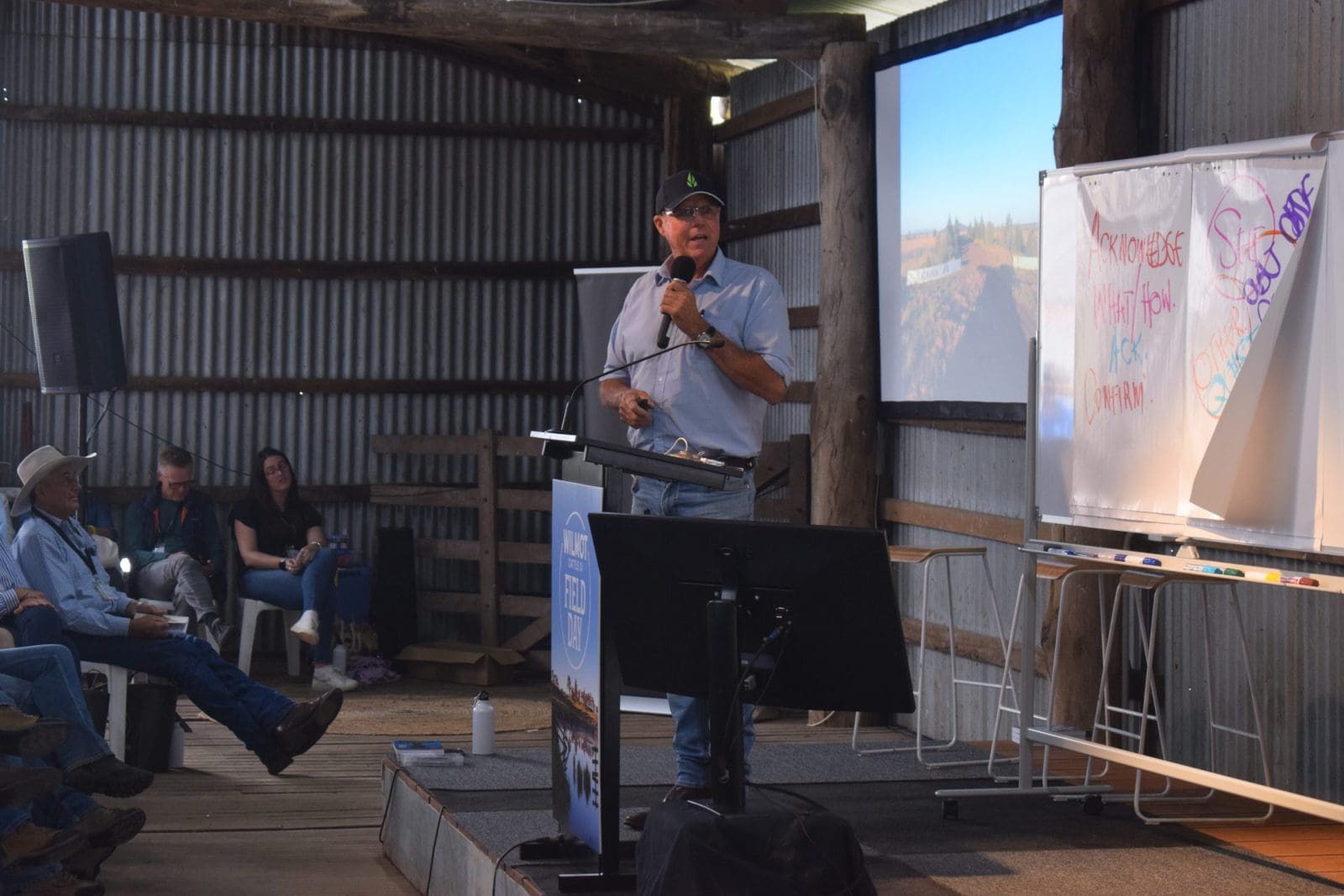
WHILE building soil carbon in grazing systems has been garnering plenty of attention in recent months, a New South Wales farmer says it should also be a focus for crop growers.
Scott McCalman gave last month’s Wilmot Field Days an entertaining look at his operation, Jedburgh Farms, where equipment is manufactured on farm if it is not commercially available and soil health is a major focus.
He started his presentation by thanking Wilmot for including cropping in the soil health discussion, which he said was not often the case.
“We have spoken today about things like overgrazing; we have similar issues in the cropping industry with over-cultivation.”
Jedburgh Farms consists of three properties north-east of Mullaley on the Liverpool Plains, primarily growing cotton, sorghum, wheat, and cover and opportunity crops.
Mr McCalman said improving the soil health and putting nutrients in the ground through management had been a focus for a lot of years.
“The focus (is) on soil health for risk management reasons,” Mr McCalman said.
“When I left university and came back to farm, focusing on our gross margins and cost of production was top of the list of priorities.
“With present-day costs of production and the impacts of climate change, sound risk-management strategies have become a key focus of our business.
“Cover crops have become a platform to grow nutrition, improve soil health, and bring many other associated benefits like weed suppressions.”
With building soil carbon a major focus of the operation, the McCalman family has looked into starting a soil-carbon project and making the operation available for generating credits.
However, Mr McCalman told AgCarbon Central he could not find a scheme that facilitated the outcomes he was looking for.
“Soil carbon for cropping enterprises at present is probably not being catered for in a realistic manner.
“Because Australia has such a hot and highly variable climate, a modern soil carbon/soil health program needs to provide more capacity and flexibility in sound landscape management practices, rather than just the single focus on soil carbon being the ‘holy grail’.
“It needs to be inclusive and facilitate more ground-cover, less bare soil, focus on catching more rainfall more efficiently, reducing wind, water and soil erosion, bringing in buffer zones and refuge zones within your landscape all becoming big-picture priorities that will ultimately be creating better soil health environmentally, economically and socially.
Cover crops a gamechanger
Mr McCalman said maintaining ground cover and introducing cover crops was a gamechanger in making the operation more efficient.
“Keeping soil under cover is vital for maintaining and improving soil health; it will create more biodiversity below ground.
“Bare soil starts to have a lot of other impacts; you have issues with radiant heat, high evaporation, poor rainfall infiltration, runoff and erosion of both water and dust.
“You are also going to diminish your soil biology.
“Covering up the ground is absolutely vital to how we run our business, alongside reducing (use) of synthetic fertiliser and chemicals.”
In the case of Jedburgh Farming, cover crops are grown over a 12-week period, with the aim of optimising soil moisture, and nutrient cycling.
“We terminate them mechanically with a roller crimper right at the vegetative stage (crop at anthesis), which locks in a lot of moisture and all the nutrition from the cover crop.
“Every time we grow one of these cover crops, we are always impressed at how much nutrition we gain in 90 days.
“I don’t think there is an imported synthetic fertiliser, which comes with a huge cost, that packs in anywhere near as much nutrients as the cover crops do.”
Prior to the cover-cropping regime, the McCalmans were growing various pulse crops in the rotation, with cotton, sorghum and wheat being the main profit drivers.
“Because the cover crops are such a good nutrition package, it was leaving the chickpeas, mungbeans and faba beans high and dry.
“From a risk-management perspective, the market for pulses is tough to navigate.
“The good years tend to take care of themselves because of better seasonal conditions, but the soil health benefits and the ground-cover from cover crops really shine in the poor years.
The fact cover crops are totally covering the soil, creating an insulation layer on the surface, we are finding we have allelopathy from the decaying cover crop that helps with in-fallow weed control post crimping.
“Plus, the ground-cover really helps with fallow efficiency in regard to soil health, as the soil remains cooler, biology is amplified, and we get more moisture capture.”
Cotton important in soil-health rotation
Mr McCalman said cover cropping has been a work in progress over a lot of years, and has involved some failures and successes.
He said they work out how to select cover crops that are applicable to the program, with rain-grown cotton also an important part of the mix.
“By far the most successful cover crops in our business are temperate seasonal crops, with a mix of cereal annuals, broadleaf annuals, legumes and some perennials.
“Cotton is often bagged, but from a soil-health perspective, it is very beneficial for our rotations.
“It is a perennial and we grow it in really wide rows, so we get huge root growth which provides a platform for the next crop and offers deep nutrient cycling.”
Mr McCalman said he was originally doing 1.5m rows but had decided to move it out 2.4m rows to promote more root growth.
He said it was a robust risk-management tool, with the wider rows giving the cotton more soil profile, soil moisture, nutrition and more resilience.
“We are finding this is giving us more consistently higher yields and better lint quality.
“We were finding our old configuration of 1.5m was good until about mid-January and then if we didn’t get a good rainfall event, the narrow row crop would’ve used up all the moisture profile.”
Batching biological fertilisers on farm
In order to tailor the fertiliser program to the needs of the operation, the McCalman family decided to build their own fertiliser batching plant out of cone-bottom 5000L fish farm tubs.
“We buy in the concentrated biology and trace elements and custom-blend our own fertiliser mix.
“The nutrition is put out as a liquid inject at planting.
“The idea is to keep the nutrition and keep our costs down.
“Typically, we are running about 30L/ha, which is costing us about $35 to $55/ha.”
Mr McCalman said he had only been using a small percentage of nitrogen in the fertiliser mix as he was getting good nitrogen cycling in the soils.
“As we are moving forward and getting better at managing our cover crops, our cash crops are improving and we feel we are going to bring a bit more buffered nitrogen with fulvic back into the liquid mix.”
Grain Central: Get our free news straight to your inbox – Click here

Thankyou for a wonderful look at successful regenerative cropping today. A visit to these farms would make a valuable field day and assist other farmers in regenerative practices.